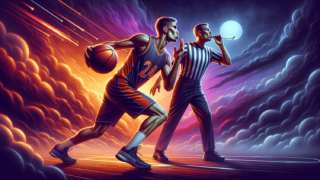
What’s a Flagrant Foul in Basketball?
Written by: Basketball Universe
Last updated:

In the immensely captivating world of basketball, there are fouls that send a clear message of “a little too far.” Enter the flagrant foul: a call that can drastically swing the momentum of a game and ignite passionate debates among fans and players alike. But what exactly constitutes a flagrant foul, and how does it differ from other, more common fouls? Buckle up, dear reader, as we dive into the high-impact, adrenaline-inducing world of flagrant fouls in basketball, shedding light on the nuances of this widely-discussed and often controversial call.
What’s a Flagrant Foul in Basketball?
A flagrant foul in basketball is a serious and intentional violation characterized by unnecessary and excessive contact against an opponent. Unlike common fouls, flagrant fouls can lead to stricter penalties such as free throws, possession of the ball, and even ejection from the game. These fouls are typically divided into two categories: Flagrant 1 and Flagrant 2, with Flagrant 2 being the more severe of the two and warranting immediate ejection of the player responsible.
The Evolution of Flagrant Fouls
The game of basketball has evolved significantly over the years, with the introduction and refinement of many rules including flagrant fouls. Today, flagrant fouls play an important role in maintaining player safety and fostering a sense of sportsmanship within the game. Let’s take a stroll down memory lane and explore the genesis and progression of flagrant fouls in basketball.
The Genesis of Flagrant Fouls
The early days of basketball were marked by a more rough-and-tumble style of play. As the sport grew in popularity and showcased a more competitive spirit, basketball’s governing bodies recognized the need for stricter rules and guidelines to protect player safety. Enter the concept of the “flagrant foul.” Conceived in the 1970s, flagrant fouls aimed to deter players from engaging in dangerous and excessively physical tactics that could result in injury.
The Progression of Flagrant Fouls
Over time, the definition and enforcement of flagrant fouls have become more refined. In 1990, the NBA divided flagrant fouls into two distinct categories: Flagrant 1 and Flagrant 2. This categorization enabled referees to differentiate between levels of severity, administering appropriate penalties for each type. The distinction between the two categories focuses on the intent and intensity behind the contact, with Flagrant 2 being the more severe of the two.
Defining Flagrant Fouls: Flagrant 1 and Flagrant 2
Now that we’ve planted the seeds of flagrant fouls history, let’s dissect the nuances of Flagrant 1 and Flagrant 2 fouls so you can spot the difference like an expert.
Flagrant 1 Foul
A Flagrant 1 foul is called when a player commits a foul that involves unnecessary contact. Referees determine the classification of a Flagrant 1 by evaluating the severity of the contact, whether the player made a genuine effort to make a basketball play, and the potential for injury inflicted on the opponent. When called, the team that was fouled is awarded two free throws and possession of the ball.
Flagrant 2 Foul
A Flagrant 2 foul is more serious and involves excessive, unnecessary, and sometimes even violent contact against an opponent. This type of flagrant foul is usually characterized by a clear intent to harm or an egregious disregard for an opponent’s safety. When a Flagrant 2 is called, the fouling player is ejected from the game, and the opposing team is awarded two free throws and possession of the ball.
Flagrant Foul Consequences and Accumulation
Flagrant fouls not only impact the game itself but can also have far-reaching consequences for the offending player and team. Let’s dive into the repercussions of committing flagrant fouls.
Ejections and Suspensions
As previously mentioned, a player who commits a Flagrant 2 foul is immediately ejected from the game. In addition, depending on the nature of the foul, the NBA or other governing bodies may choose to suspend the player for a determined number of future games. A player who accumulates two Flagrant 1 fouls in a single game will also be ejected.
Fines and Penalty Points
Players who receive flagrant fouls may be subject to monetary fines, depending on the severity of the foul and the player’s history. The NBA has a penalty point system in place, wherein Flagrant 1 fouls are assigned one point, and Flagrant 2 fouls are assigned two points. Players who accumulate a predetermined number of points during a season or playoffs may incur additional fines or suspensions.
Team Impact
The consequences of flagrant fouls extend beyond the offending player to impact the entire team. Repeated flagrant fouls can lead to a loss of valuable players due to ejections or suspensions, thereby affecting team dynamics and performance. Additionally, being known as a team that frequently commits flagrant fouls can create a negative reputation and impact team morale.
Basketball Rules: How Referees Determine Flagrant Fouls
Determining whether a foul is a flagrant 1 or flagrant 2 can be a nuanced process. The basketball rules that referees follow when making this distinction include assessing factors like contact type, intent, and severity. Let’s get a closer look at how referees differentiate flagrant fouls from common fouls.
Instant Replay Reviews
In the NBA and NCAA, referees can utilize instant replay to evaluate a potential flagrant foul. This allows them to review the contact and make a well-informed decision on the appropriate classification and subsequent consequences. The replay review also provides an opportunity for the officials to discuss and choose the best course of action collectively.
Key Factors for Flagrant Foul Assessment
When evaluating a potential flagrant foul, referees consider several factors to determine its classification. Some of these factors include:
- Severity of Contact: How impactful was the contact between players? Was the contact forceful enough to warrant a flagrant classification?
- Intent: Did the offending player show deliberate intent to cause harm or commit unnecessary contact?
- Excessiveness: Was the contact beyond what is considered reasonable or acceptable during a basketball play? Did the player act in a reckless manner that endangers others?
- Basketball Play: Was the contact part of a legitimate basketball play, or was it strictly an uncontrolled and unnecessary act?
Notable Flagrant Fouls in Basketball History
Throughout basketball history, there have been several flagrant fouls that left a lasting impact on the game and contributed to ongoing conversations about player safety and conduct. Let’s explore some of the most infamous flagrant fouls that have made their mark on basketball history.
“The Clothesline” – Kurt Rambis and Kevin McHale
During Game 4 of the 1984 NBA Finals between the Boston Celtics and the Los Angeles Lakers, Kevin McHale delivered a blatant and notorious clothesline foul on Kurt Rambis as he charged toward the basket on a fast break. The foul intensified the on-court tension and competitiveness, and the play became one of the most iconic flagrant fouls in NBA history.
“The Punch” – Kermit Washington and Rudy Tomjanovich
One of the most infamous moments in basketball history, “The Punch” occurred during a 1977 game between the Houston Rockets and the Los Angeles Lakers. In a moment of chaotic on-court confrontation, Kermit Washington punched Rudy Tomjanovich in the face, causing a wide array of severe injuries. This incident led to a significant shift in the league’s attitude toward violence and player safety in the game.
Preventing Flagrant Fouls: Sportsmanship and Basketball Etiquette
While the excitement of the game may ignite passionate plays, preventing flagrant fouls is crucial to maintaining a safe, enjoyable, and sportsmanlike atmosphere. It is essential to understand basketball etiquette and promote sportsmanship within every basketball game, whether professional or recreational.
Respect for Opponents
One of the key principles of sportsmanship is respecting your opponents. This includes acknowledging their skills, appreciating their effort, and most importantly, avoiding intentional harm or unnecessary contact. By fostering a sense of mutual respect, players can enjoy a more competitive and fair game.
Self-Control
It’s normal for emotions to run high during a basketball game, but it’s crucial for players to maintain self-control and not let these emotions lead to dangerous or overly aggressive plays. By keeping emotions in check, players can prevent actions that result in flagrant fouls and unnecessary injuries.
Awareness of Rules
Lastly, being knowledgeable of the basketball rules, including what constitutes a flagrant foul, is essential to playing the game responsibly. Understanding the difference between aggressive defense and unnecessary contact can help players make safer and smarter decisions on the court.
Flagrant fouls are an essential aspect of the game that highlights the importance of player safety and sportsmanship in basketball. By understanding the intricacies of flagrant fouls and respecting the basketball rules and etiquette, players, coaches, and fans alike can contribute to a safer and more enjoyable experience for all involved.
Common Misconceptions About Flagrant Fouls
Despite the prevalence of flagrant fouls in basketball, various misconceptions surrounding these fouls can often cause confusion for fans and players alike. Let’s debunk some of these common myths to ensure a deeper understanding of flagrant fouls and their implications within the game.
Myth: All Hard Fouls are Flagrant Fouls
While hard fouls involve significant contact between players, not all hard fouls are considered flagrant. To constitute a flagrant foul, unnecessary and excessive contact must be evident. If a hard foul occurs within a permissible basketball play and doesn’t involve malicious intent or recklessness, it may not be classified as a flagrant foul.
Myth: Flagrant Fouls Always Involve Malicious Intent
Though many flagrant fouls involve a player’s deliberate intent to harm or initiate unnecessary contact, this is not always the case. Some flagrant fouls may occur due to reckless actions, exaggerated follow-throughs, or lack of body control, which still endanger opposing players despite the absence of malicious intent.
Myth: A Player Cannot Receive Both a Technical Foul and Flagrant Foul Simultaneously
While flagrant fouls deal with excessive physical contact, technical fouls often involve unsportsmanlike conduct or behaviors that do not adhere to the game’s spirit. In some cases, a single action could lead to both a flagrant and technical foul being called against a player, such as excessive contact followed by inappropriate behavior, taunting, or uncontrolled emotional outbursts.
Influence of Flagrant Fouls on Basketball Strategies
Sometimes, teams might implement strategic moves that, albeit controversial, involve leveraging flagrant fouls. Understanding these strategies, along with their potential risks and rewards, can provide valuable insight into the tactical and psychological aspects of basketball.
“Hack-a-Shaq” Strategy
Named after the poor free-throw shooting performance of former NBA player Shaquille O’Neal, the “Hack-a-Shaq” strategy involves intentionally fouling a poor free-throw shooter on the opposing team. Although this tactic has raised ethical questions and stirred controversy, it’s occasionally utilized by teams to exploit an opponent’s weakness, forcing the fouled player to shoot free throws instead of allowing high-percentage shots.
However, intentional fouling may result in flagrant foul calls if the contact is excessive, emphasizing the need for caution amid implementing such a strategy. Additionally, the NBA has altered its rules over time to counteract the “Hack-a-Shaq” strategy, penalizing away-from-the-ball fouls in the last two minutes of each quarter with a single free throw and possession for the fouled team.
Intimidation Through Physical Play
Some teams or players may adopt a more physical style of play to intimidate their opponents, suppress their performance, and disrupt their rhythm. By implementing this strategy, players can occasionally toe the line between aggressive and flagrant fouls, ultimately leading to heated contestations and controversial calls from referees. While these tactics hold the potential to yield short-term advantages, they might result in long-term drawbacks, including reputation damage and potential injuries for both sides.
Risky Gamble or Pure Sport: Striking the Right Balance
Strategizing with an element of physicality can be a risky gamble, often affecting team morale and individual performance. While flagrant fouls might provide momentary advantages, it’s the player’s responsibility, guided by a strong sense of sportsmanship, to ensure that the spirit of the game is not compromised. Skill, agility, creativity, and unwavering discipline remain the pillars of basketball’s true essence, shaping the game into the enthralling spectacle it is today.
FAQ: Frequently Asked Questions About Flagrant Fouls
Still curious about flagrant fouls? Here’s a compilation of frequently asked questions that will help you further expand your knowledge on flagrant fouls and their impact on basketball. Let’s dive right in!
1. What type of contact is considered “unnecessary” for a Flagrant 1 Foul?
Unnecessary contact usually involves a player making forceful contact with an opponent in a situation where such contact could have been avoided, or if it serves no legitimate basketball purpose. The intent is not always malicious, but the contact is considered excessive in relation to the game’s physical nature.
2. What happens when a player accumulates too many flagrant foul points in a season?
When a player accumulates a certain number of flagrant foul points during a season or playoffs, they may be subjected to additional penalties, such as fines or suspensions. The NBA’s penalty point system assigns one point for each Flagrant 1 foul and two points for each Flagrant 2 foul.
3. Can a coach challenge a flagrant foul call?
In the NBA, coaches can challenge certain calls made by referees, including flagrant fouls. If a coach believes that a flagrant foul call is incorrect, they can request a review to potentially overturn the initial decision.
4. How are flagrant fouls treated differently in college basketball compared to the NBA?
In general, the flagrant foul rules in college basketball are quite similar to those in the NBA. However, college basketball might use different terminology, referring to Flagrant 1 and Flagrant 2 fouls as “Flagrant 1 Personal” and “Flagrant 2 Personal” fouls, respectively.
5. How do referees determine whether the contact is unnecessarily excessive?
Referees assess the severity of the contact, the fouling player’s intent, whether the action was part of a legitimate basketball play, and the potential risk of injury for the player being fouled. They may also utilize instant replay to review the incident and make an informed decision collaboratively.
6. What is a “double flagrant foul” in basketball?
A double flagrant foul occurs when two players from opposing teams commit flagrant fouls against each other simultaneously or in quick succession. Both fouls are penalized, and if the fouls are severe enough or involve fighting, both players may be ejected from the game.
7. Can a team intentionally commit a flagrant foul as a strategy?
While it’s possible for a team to intentionally commit a flagrant foul as a strategy, doing so comes with significant risks, including penalties and potential for player ejection or suspension. Moreover, it exhibits poor sportsmanship and can tarnish a team’s reputation.
8. What happens if a player commits a flagrant foul while attempting to block a shot?
If the referees determine that the contact made during the block attempt was unnecessary or excessively forceful and didn’t constitute a legitimate basketball play, a flagrant foul can be called. The classification of the flagrant foul (Flagrant 1 or Flagrant 2) will depend on severity and intent.
9. How do officials distinguish between a flagrant foul and a common foul during a hard screen?
Referees assess factors such as severity of the contact, intent of the player setting the screen, and whether the screen was part of a permissible basketball play. If the contact was unnecessarily excessive or the action poses potential injury risks, a flagrant foul may be called instead of a common foul.
10. Are there any significant differences in how flagrant fouls are called in international competitions, such as the Olympics or FIBA games?
FIBA (International Basketball Federation) and NBA rules differ slightly in their handling of flagrant fouls. FIBA defines flagrant fouls as “unsportsmanlike fouls” and uses a simpler two-category system: “Unsportsmanlike Foul” and “Disqualifying Foul,” roughly equivalent to the NBA’s Flagrant 1 and Flagrant 2, respectively.
Featured Posts
- No pillar pages found.





